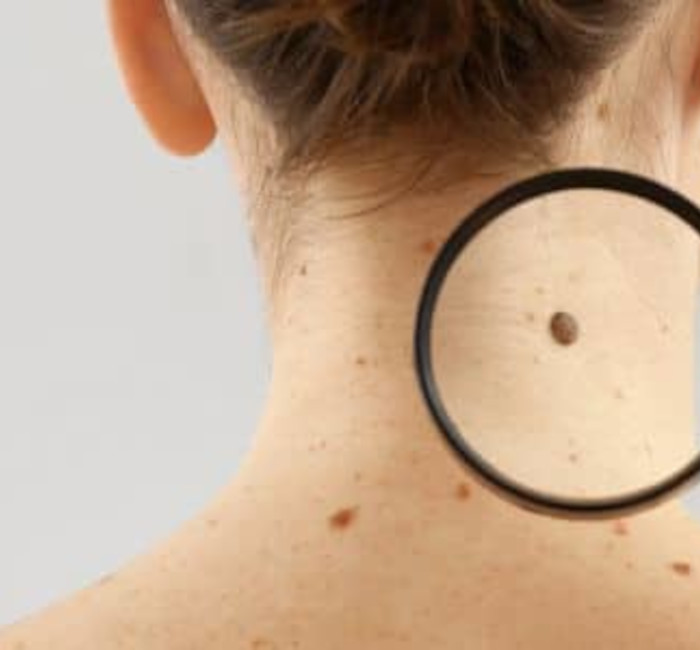Procedures
Mole Excision

When you notice a new spot or growth on your skin, it’s natural to wonder about it. Moles are common skin lesions that nearly everyone has. They can be present from birth or can appear as you grow. Most moles are harmless and don’t require medical treatment. However, in some cases, you may need or choose to have a mole removed. This is where mole excision comes into play. Understanding when and why mole excision might be necessary and what the procedure involves, can help alleviate any apprehensions you might have about the surgery.
Consultant Plastic Surgeon Anca Breahna will provide you with detailed insights into everything from the reasons for mole excision to the recovery process, helping you to understand the full scope of what to expect.
At a glance
Depends on the type of procedure perfomed
Local anaesthesia
A few days to a few weeks.
One time.
Table of Contents
What is Mole Excision?
Mole excision, or mole removal, is a medical procedure that involves surgically removing a mole from the skin. The purpose of this procedure can be diagnostic, therapeutic, or cosmetic.
Who Needs Mole Excision?
Mole excision is not a procedure that everyone with a mole will require. In fact, most moles are completely benign and will never cause any problems. However, there are specific circumstances where you might consider or be advised to have a mole removed. These situations can generally be grouped into three categories: medical necessity, physical discomfort and personal preference.
Medical Necessity
The primary medical reason for mole excision is the potential for skin cancer. If a mole exhibits signs of malignant changes, such as an increase in size, irregular edges, changes in colour, or an asymmetrical shape, Anca will likely recommend a biopsy or complete removal to ensure it isn’t cancerous. Early removal and examination of potentially cancerous moles are key to preventing the spread of skin cancer.
Physical Discomfort
Some moles can become a nuisance if they frequently catch on clothing or jewellery, causing irritation or even pain. Moles located in areas prone to friction, such as under your arms or around your neck, can also lead to discomfort and skin irritation. In such cases, removing the mole can provide significant relief and prevent further skin problems.
Personal Preference
Many people choose mole excision for cosmetic reasons. If you feel that a mole is visually unattractive or if it’s in a prominent location such as your face or neck, you might opt for excision to improve your appearance. This is a personal decision and involves weighing up how much the mole bothers you against the minor risks associated with surgical removal.
Regardless of your reason for considering mole excision, it is important to consult with Anca. She can assess the mole and discuss potential risks and benefits to help you make an informed decision based on your health needs and aesthetic desires.
Benefits of the Mole Excision Procedure
Mole excision can offer several advantages, depending on why you are considering the procedure. It’s important to have clear goals and realistic expectations to truly appreciate the benefits:
Health Monitoring and Cancer Prevention
One of the most significant benefits of mole excision is the ability to test the mole for cancerous cells. If you have a mole that has changed in appearance, the excision allows for detailed pathological examination. Early detection and removal of pre-cancerous or cancerous moles can be lifesaving.
Improved Physical Comfort
If a mole is located in an area where it is constantly irritated by clothing or jewellery, removal can end this ongoing discomfort. Once the mole is removed and the area has healed, you will no longer have to worry about the pain or irritation that such moles can cause.
Enhanced Appearance
For many people, the cosmetic improvement following mole excision is highly beneficial. Removing a mole that you feel is unattractive can significantly boost your happiness with your appearance. This is particularly true for moles on the face or other highly visible areas, where even a small mole can make a big difference to how you see yourself and how you believe others perceive you.
Types of Mole Excision Procedures
Shave Excision
Shave excision is a simple procedure used primarily for moles that protrude above the skin surface. During this procedure, Anca will use a small blade to shave the mole down to the level of the surrounding skin. This method is quick and usually doesn’t require stitches, which means the recovery time is relatively short. However, since the mole is not removed deeply, there’s a higher chance it could recur.
Punch Biopsy
A punch biopsy is not only a diagnostic tool but also a way to remove small moles completely. Using a circular tool, Anca punches out a cylindrical piece of skin that includes the entire mole. This method is effective for smaller moles and usually requires a stitch or two to close the small hole left by the punch.
Excisional Surgery
Excisional surgery is the most comprehensive method for mole removal. It involves using a scalpel to cut out the mole and a margin of healthy skin around it. This technique is often used for larger moles or those that are suspected of being malignant. The wound is then closed with stitches, which might be located either on the surface of the skin or underneath it, depending on the depth of the cut.
How is the Mole Excision Procedure Performed?
The mole excision procedure is generally straightforward and performed as an outpatient service, meaning you won’t have to stay in the hospital overnight. Here’s what you can expect:
- Preparation: You’ll first discuss your medical history and any allergies to medications with Anca. The area around the mole will be cleaned to prevent infection, and you’ll be given a local anaesthetic to numb the area. This helps ensure that you won’t feel any pain during the procedure.
- The Excision: Depending on the method being used (shave, punch, or excisional), Anca will either shave off, punch out, or surgically remove the mole, along with any necessary margin of tissue. The goal is to remove the entire mole for examination and/or to ensure it does not cause further issues.
- Closing the Wound: If stitches are required, Anca will use them to close the wound. For shave excisions, stitches might not be necessary. A bandage will be applied over the site to protect it from infection and to help absorb any minor bleeding.
- Aftercare Instructions: You will receive instructions on how to care for the wound at home, which might include keeping it clean and dry, applying antibiotic ointment, and returning to have stitches removed if necessary.
Recovery after Mole Excision Procedure
Recovery from mole excision depends significantly on the type of procedure you’ve undergone. Here are some general guidelines:
- Shave Excision and Punch Biopsy: These methods usually heal within a few weeks. You might need to apply an antibiotic ointment to prevent infection and to aid in healing. It’s usually advised to keep the wound covered until it heals fully.
- Surgical Excision: This method may take longer to heal, depending on the size of the wound. You’ll need to manage your stitches, keep the area clean, and possibly take prescribed pain relief medication. Avoid strenuous activities that could stress the wound site during your recovery.
In all cases, follow-up appointments are important to ensure proper healing and to discuss any findings from the mole’s pathological examination.
Reviews
Patient satisfaction is the top priority for Anca. You can find how patients feel about her work below.
Wish I’d Done It Sooner! I am so pleased with the results
After searching and deliberating for a long time, I consulted Anca regarding the removal of 3 lipomas. From start to finish, she was fantastic! One of the lipomas was on my forehead and I have to search for the scar! I am so pleased with the results of all and the one regret is that I didn’t find her sooner. I wouldn’t hesitate to recommend her

Miss Breahna removed a cancerous nodule from my forehead in March 2021. I was quite nervous when I arrived at the hospital, but when I was greeted by a member of her team I started to feel calmer as they were so professional and friendly. Once inside the theatre Miss Breahna and her team helped me to feel relaxed and comfortable throughout, the team atmosphere was friendly and upbeat during my operation and I was looked after wonderfully. I would recommend Miss Breahna and her team to anyone requiring this type of surgery.
Kate Hodson

Ms Anca Breahna was most kind and empathetic during my recent procedure for skin cancer. She reassured me that I’m now completely clear, I have total confidence in her and would recommend her unreservedly. Thank you Anca.
How Much Does Mole Excision Cost?
The financial aspect of mole excision can vary greatly based on several factors including the method used, the complexity of the procedure, and the setting in which it is performed. Here’s what you need to consider when evaluating the cost of this procedure:
- Type of Procedure: Different methods of mole removal come with different costs. Shave excisions are generally less expensive than punch biopsies and surgical excisions because they are simpler and often do not require stitches.
- Location and Setting: Having the procedure done in a hospital as opposed to a private plastic surgery clinic can affect the cost due to the differing overheads and service fees associated with each type of facility.
- Geographic Location: Costs can vary significantly from one region to another depending on local market conditions and the cost of living.
NHS vs Private Costs
In the UK, mole excision might be covered by the NHS if it is deemed medically necessary, that is, if the mole is suspected of being cancerous or if it causes significant discomfort. For cosmetic reasons, however, you would likely need to pay for the procedure privately.
Please contact us for an estimated price range. It’s always a good idea to get a detailed quote beforehand and to check if your health insurance might cover some or all of the costs.
Cost of Surgery Guide

Further Reading
- Read more about Lip Lesion Excision
- Read more about Biopsy Incision
- Read more about Wart Removal
- Read more about Ganglion Removal
- Read more about Skin Surgery

Procedure
Frequently asked questions
What are the risks associated with mole excision?
Like any surgical procedure, mole excision comes with certain risks, though they are generally minor. These risks include infection, bleeding at the site of the excision, scarring, and in rare cases, an allergic reaction to the anaesthetic used during the procedure. There is also a small chance that the mole might regrow if the excision does not completely remove all the mole cells. Make sure to ask about the potential risks and complications that can occur after your mole excision procedure during your consultation with the plastic surgeon.
Can mole excision lead to a misdiagnosis of cancer?
Mole excision itself does not lead to a misdiagnosis. In fact, it is a step towards ensuring an accurate diagnosis. The excised mole is usually sent to a lab for histological analysis, where pathologists examine the tissue under a microscope to check for signs of cancer. This thorough examination helps in making an accurate diagnosis.
How should I prepare for a mole excision procedure?
Before your mole excision, it’s important to discuss your full medical history and any medications you’re taking with Anca. Avoid taking aspirin, anti-inflammatory drugs, and herbal supplements as they can increase bleeding. It’s also advisable not to drink alcohol the night before and to arrive with a clean skin area free of any creams or makeup.
What should I expect in terms of scarring after mole excision?
The possibility of scarring depends on the mole’s size, the technique used for removal, and your skin type. Generally, shave excisions leave minimal scarring, while surgical excisions might leave a small line or stitch marks, which fade over time. Anca may recommend post-procedure treatments like silicone gel sheets to minimise scarring.
How long do I need to avoid physical activity after mole excision?
It is generally recommended to avoid strenuous physical activities that could stretch or stress the excision site for about 1-2 weeks following the procedure. This helps ensure proper healing and prevents the wound from reopening. Light activities, such as walking, are usually fine and can help with overall circulation and healing. Always follow the specific guidelines provided by Anca and her team based on your individual circumstances.
Medical References about Mole Excision
- Mole Removal: Surgery, Aftercare & Scars – Cleveland Clinic
- Removing your mole (excision biopsy) – Cancer Research UK
- Mole removal scar: Healing and treatments – Medical News Today
- Removal of Moles – Pub Med
- Moles – Diagnosis and treatment – Mayo Clinic
 Ms Anca Breahna, PhD, MSc, FEBOPRAS, FRCS (Plast) is a highly regarded Consultant Plastic Surgeon specialising in the field of Aesthetic and Reconstructive Plastic Surgery. Anca performs a range of
Ms Anca Breahna, PhD, MSc, FEBOPRAS, FRCS (Plast) is a highly regarded Consultant Plastic Surgeon specialising in the field of Aesthetic and Reconstructive Plastic Surgery. Anca performs a range of 